Dr. Alison Leitch
Magma Mingling in the Holyrood Granite
Student: Pat O’Grady Co-investigator: Greg Dunning
The 620 Ma Holyrood Intrusive Suite, part of a horst on the eastern Avalon Peninsula, Newfoundland, is comprised of rocks ranging from diorite to granite. In a coastal exposure, the granite host was intruded by darker tonalite blobs. In this field, petrographic and geochemical study, the relationship between the magmas and their relative rheologies were examined to determine their dynamic history.
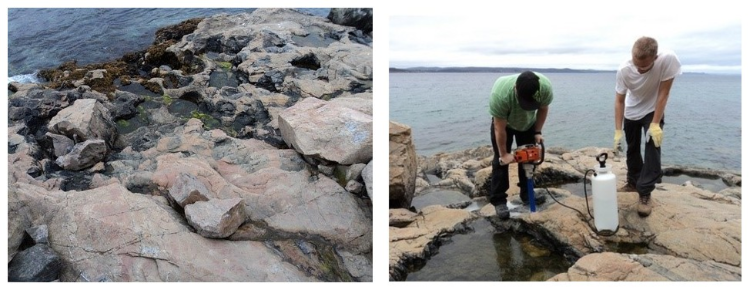


Outcomes:
BSc Hons: Patrick O’Grady (2013) “Magma mingling in the Avalonian Holyrood Granite”
Leitch, A.M., O’Grady, P. and Dunning, G., “Magma mingling in the Avalonian Holyrood Granite”, GAC MAC Annual Meeting, Fredericton, NB, May 21-23, 2014.
O’Grady, P., Leitch, A.M. and Dunning, G., “Magma mingling in the Avalonian Holyrood Granite”, AGS Annual Meeting, Dartmouth NS, 2013.
O’Grady, P., Leitch, A.M. and Dunning, G., “Magma mingling in the Avalonian Holyrood Granite”, NL GAC Annual Spring Meeting, St John’s NL, 2013.
Analog Experiments in Magma Mingling
Student: Kriselle Dias
New influxes of magma preferentially intrude fluid, crystal-poor regions of magma chambers. The input magma may have different composition and rheology to the host. We investigated the effects of density, viscosity and crystallinity contrasts on the interaction of host and input using aqueous analog materials in a dm-scale glass tank. Salts were used to control density, cellulose to change viscosity, and plastic and glass beads to simulate crystallinity. Many different behaviours were observed.
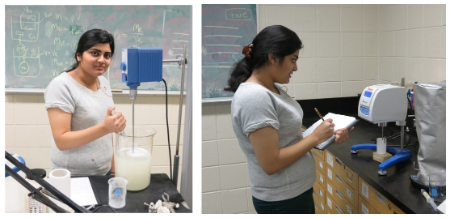
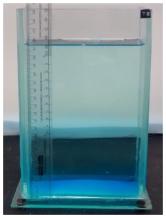
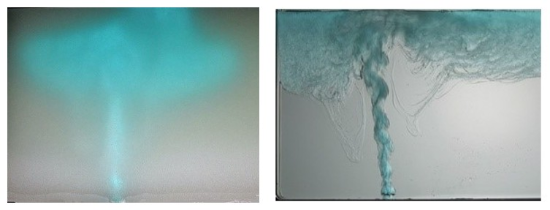
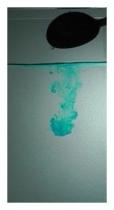
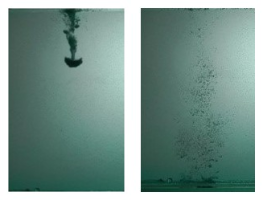
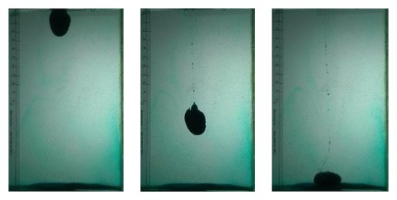
Outcomes:
BSc Hons: Kriselle Dias (2015) “Laboratory modelling of magma mingling”
Dias, K. and Leitch, A.M., “Laboratory Modelling of Magma Mingling”, AGS Annual Meeting, Sackville, NB, Jan 30-Feb 2, 2015. *(Best undergraduate poster award.)
Dias, K. and Leitch, A.M. “Laboratory Models of Magma Mingling” (in prep for Atlantic Geology).
Potential Fields and Structural Study of the Howley Basin
Student: Linden Ernst Co-investigator: Tom Calon
The Howley Basin in western Newfoundland is a potential source of hydrocarbons. The field part of this study involved extensive field mapping of surficial structure; gravity and RTK surveying over land and ice; and a GPR bathymetric survey of Sandy Lake. Pre-existing magnetics and gravity data was incorporated into the processing to produce a model of the depth and structure of the Howley Basin and its hydrocarbon potential.
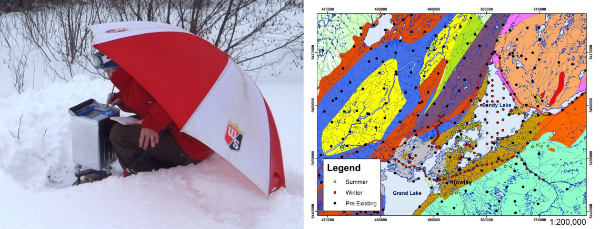
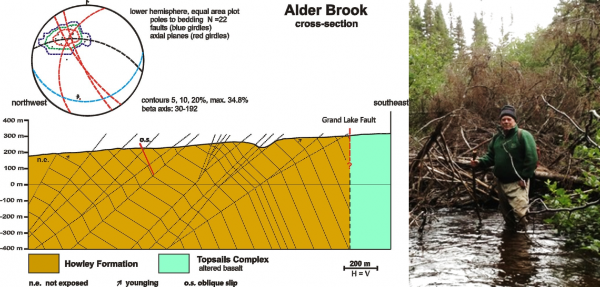
Outcomes:
MSc: Linden Ernst (2018 submitted) “Gravity Surveying, Potential-field Modeling, and Structural Mapping and Analysis of the Howley Basin, western Newfoundland” (co-supervised by T. Calon)
Ernst, L., Leitch, A. and Calon, T., “Potential Field and Structural Analysis of the Howley Basin, Western Newfoundland”, GAC MAC Annual Meeting, Whitehorse, Jun 1-3, 2016.
Ernst, L., Calon, T., Leitch, A.M., “Revisiting structure and gravity of the Howley Basin”, GAC MAC Annual Meeting, Fredericton, NB, May 21-23, 2014.
Geophysical Signals of Reducing Springs (Bay of Islands Ophiolite)
Students: Stephanie Abbott, Nicholas Lynch, Linden Ernst
The Tablelands massif in western Newfoundland is part of the Bay of Islands Ophiolite, segments of the Earth’s upper mantle which were thrust onto the surface when the island was assembled. Ground water interacting with these unusual rocks results in the production of unusually alkaline spring water, and the production of magnetite. Magnetic and electrical surveys are thus able to map ground water flow through invisible fracture systems, and detect springs for geochemical studies. The Tablelands is a Mars analogue site: these reactions may occur on the Red Planet.
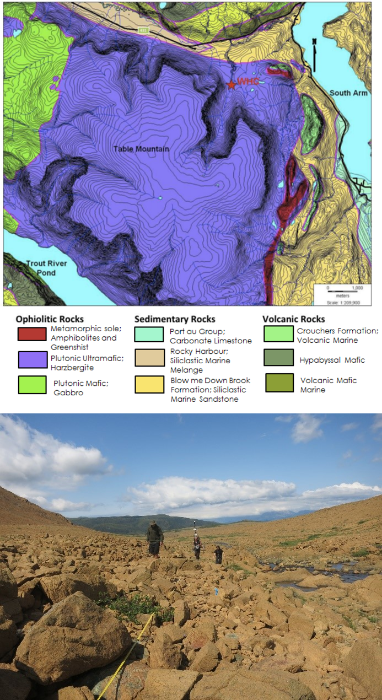
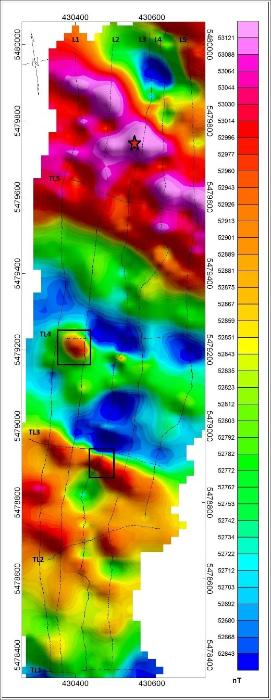
Outcomes:
BSc Hons: Linden Ernst (2012) “Self-Potential and Magnetic Detection of a Reducing Spring”
BSc Hons: Nicholas Lynch (2016) “Geophysical detection of reducing springs using magnetics and a newly developed self potential system” *(Peterman prize for best thesis, 2016.)
BSc Hons: Stephanie Abbott (2018) “Magnetic signature and petrography of serpentinized fractures in the Tablelands ophiolite”
Lynch, N. and Leitch, A.M. (2018) “Magnetic and Electrical Surveys in the Bay of Islands Ophiolite, Newfoundland: New Methods for Detecting Faults and Springs” (in prep for Earth Planetary Research Letters)
Multiple Mush Magmas of the Fogo Batholith
Student: Ben Graham Co-investigator: Greg Dunning
Fogo Island, the largest island off Newfoundland, is underlain by a Silurian-Devonian batholith which is gabbroic in the south and granitic in the north. In Wild Cove East there are mingled intermediate rocks exposed along the coastline. This combined field, petrographic and geochemical study examined the mingling on multiple scales to elucidate the dynamic history of the rocks. A drone imagery survey helped to produce a base map.
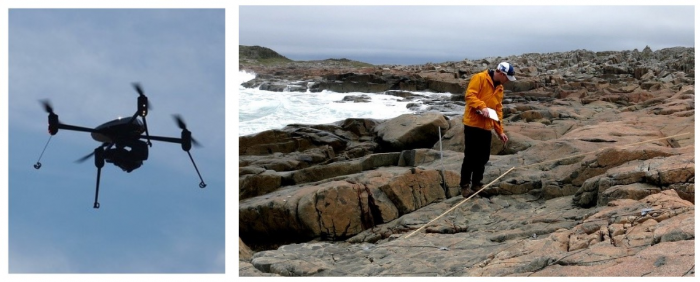
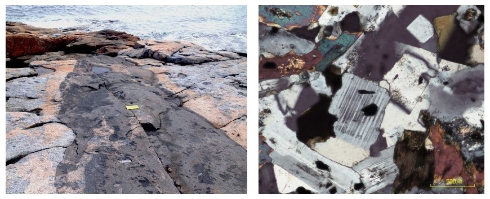
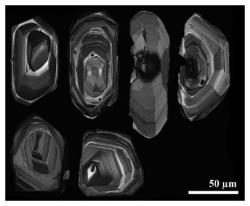
Outcomes:
MSc: Ben Graham (2017) “A field and laboratory study of magma chamber processes in the development of a plutonic suite on Fogo Island, Newfoundland” (co-supervised by G. Dunning).
Graham, B., Dunning, G. and Leitch, A., “Early Devonian Magmatism, NE Dunnage Zone, Newfoundland and the nature of basaltic to granitic additions to large magma chambers”, AGS Annual Meeting, Truro NS, 2018.
Graham, B., Leitch, A. and Dunning, G., “Mingling of magma mushes”, AGU Fall Meeting, San Francisco, 2016.
Graham, B., Leitch, A. and Dunning, G., “Mingling of crystal-rich magmas in the Fogo Island Batholith”, NL GAC Annual Spring Meeting, St John’s NL, 2016.
Graham, B., Leitch, A. and Dunning, G., “Magma Mushes of the Fogo Island Batholith” (in prep for the Journal of Petrology).
GPR and Coring of Lake Sediments
Student: Jianguang Chen Co-investigator: Elliott Burden
GPR surveying of a km-scale post-glacial lake over a gold prospect revealed intriguing layering within the soft sediments. Long cores of the sediments were collected and physical and chemical properties of the muds were measured in the laboratory to find the cause of the GPR reflections and investigate chemical variability of the muds in time and space.
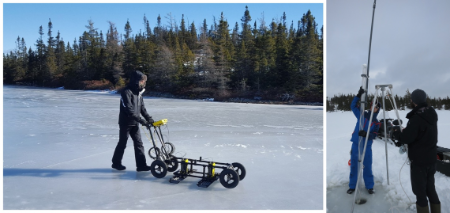
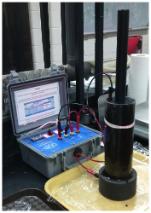
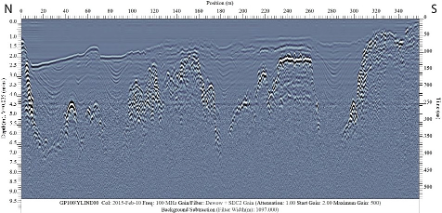
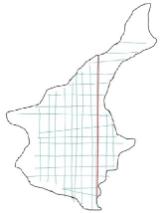
Outcomes:
MSc: Jianguang Chen (2018) “Ground Penetrating Radar Surveying and Sediment Coring Analysis of a Post-Glacial Lake, Eastern Newfoundland” (co-supervised by E. Burden)
Chen, J., Leitch, A. and Rashid, H., “Using Ground Penetrating Radar to Investigate Lacustrine Sediments for Paleoclimatic Reconstruction”, Canadian Quaternary Association Conference, St John’s, NL, 16-18 August, 2015.
Chen, J., Leitch, A. and Burden, E., “Sediment core analysis of a post-glacial lake over a mineral prospect, Eastern Newfoundland”, NL GAC Annual Spring Meeting, St John’s NL, Feb 19-20, 2018.
Chen, J., Leitch, A., Burden, E. and Finch, C. “Lake sediment core analysis over a gold prospect, Eastern Newfoundland”, 9th PDAC-SEG Student Minerals Colloquium, March 3-7, 2018.* (3rd place, MSc student posters.)
Delineating the Alteration Zone of a Gold Prospect
Student: Adam Wall Co-investigators: Colin Farquharson, Greg Sparkes
Hydrothermal gold deposits are associated with alteration of local rocks, changing their density and magnetic properties. Gravity and magnetic surveys were carried out over the Big Easy gold prospect, and the data were mapped and modelled in order to localize the alteration zone, and hence the gold mineralization.
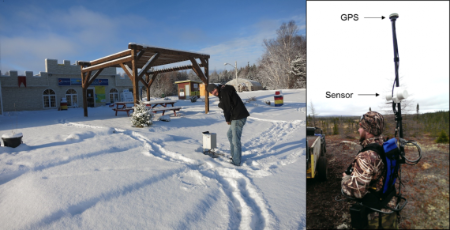
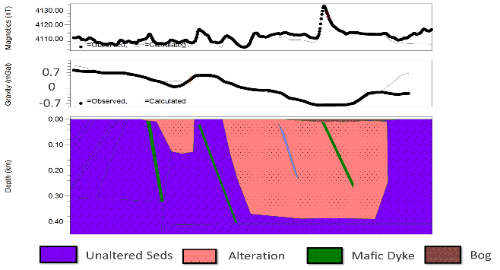
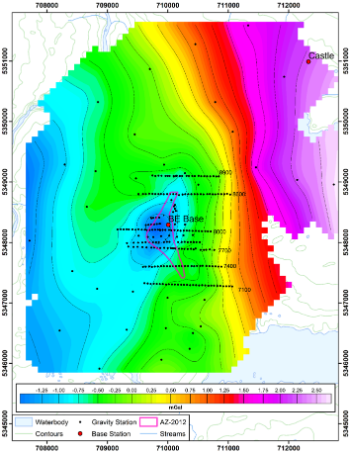
Outcomes:
MSc: Adam Wall (2018) “Delineating the Alteration Zone at the Big Easy Prospect using Geophysical Methods” (co-supervised by C. Farquharson)
Wall, A., Leitch, A., Farquharson, C. and Sparkes, G., “Delineating the alteration zone at the Big Easy prospect using geophysical methods”, GAC MAC Annual Meeting, Whitehorse, Jun 1-3, 2016.
Wall, A., Leitch, A.M., Sparkes, G. and Farquharson, C., “Delineating the Alteration Zone at the Neoproterozoic, Low-Sulphidation Big Easy Gold Prospect Using Geophysical Methods” (in prep for Economic Geology).